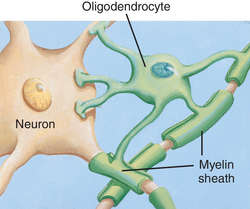Multiple sclerosis (MS) is a degenerating disease where the immune system strips away the fat tissue that coats the neurons of the brain. The neurons are the brain cells and nervous cells in our bodies that are in charge of passing messages across our bodies (i.e. sensory, coordination, moving, etc.). This fat is made of myelin. As the myelin insulation is stripped, the axons, the parts of the neuron that passes electrical signals to other neurons, is not able to conduct as well. This causes the messages to pass slower, and the patient begins to develop symptoms. These symptoms include visions loss, impaired coordination, paralysis, and a lot more. This demyelination (degeneration) can occur in all parts of the body. The loss of sensation and muscle spasms depends on the area the disease occurs.
Oligodendrocytes are the cells that replenish myelin on the axons (remyelination). This is our bodies’ natural defense against demyelination. Many experiments and labs were done on cats and monkeys to observe the activity of these oligo cells. Studies found that the oligo cells move up and down the spinal cord in a cat to resupply neurons with myelin. In a cat with MS, the oligo cells moved too slow to keep up with the loss of myelin surrounding the axons.
Scientists now believe that MS can be stopped and even reversed using therapeutics and drugs that help the body produce more oligo progenitors, the cells that produce oligodendrocytes.
Source: https://news.wisc.edu/discovery-opens-new-opportunities-to-slow-or-reverse-ms/


